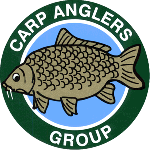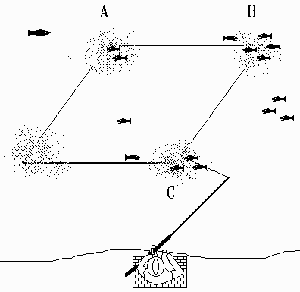
There is an art to chumming. If you over feed an area, the fish will shut down and you will not catch them. Too little food and they will move on to a better place. Fortunately, carp are eating machines and they travel in packs, so it is hard to overfeed them, at least in North America. In England overfeeding is possible, but that's because there are fewer fish and they are trained to eat one kind of food (the locally popular boilie) and will turn off regularly.
The rule of thumb in North America is "If you chum, they will come".
You can chum with anything, but the best way to start is with corn. Canned sweetcorn is the most available and it is easily introduced with a catpult (which is the English word for a fishing slingshot) or a spod.
After a while you will learn what to chum with, where to chum and how much. You can fish with the same bait you use in your chumming or you can use something different in the hope of attracting a fish. The neat thing about fishing is that you constantly have to try to outsmart them.
Keep reading, below is a chapter from Modern Bank Angling on the fine art of chumming.
Introduction
The System
How to Chum
Groundbaiting
Philosophy of Chumming
In their educational brochure Class Tackle likens chumming to feeding pigeons in the park. It says that the process of feeding fish is much the same. You wouldn't throw all of your popcorn at one or two pigeons, they would eat it quickly then leave. If you feed little and often, eventually many pigeons would come. The same is true with fish. Feed little and often, even while you have a fish on the line! This keeps the fish interested and triggered to eat. If you stop for a few minutes they may lose interest and move on.
One of the best baits to chum with is maggots. While they tend to be expensive in this country, maggots can still be used as chum because they are tough and stay on the hook until chewed off by the fish. As a result one maggot can be used again and again. They are so succulent that even the skins will capture the attention of bluegill. If you catch 100 fish in a session and have 100 maggots to fish with, you may only need 20 maggots for hook bait. The rest can be used as chum.
Specimen anglers will pre-bait a section of the water
in order to accustom fish to the bait they are using. Because some of these
baits are never found in nature many fish ignore them at first. After a
while they become accustomed to them and may even switch to the offerings
exclusively if they are both nutritious and easy to find. The angler can
use the same or similar bait on his hook and catch fish. Sweetcorn works
as both as chum and bait for hatchery trout because most of their food
has been grain based and they will have an affinity for corn. The state
has already done the majority of the chumming for you.
To Index
Chumming is the basis of the match fisherman's success in Europe. These fishing matches have a time limit (usually five hours) during which the angler has to attract a school of fish, keep them in his area and away from his opponents, and catch as many as possible. The rules allow a preliminary period during which the contestant can feed the waters with whatever he wants within the rules. After that he can only loose feed his bait.
In this preparation period an angler might throw several gallons of bait into the water. He usually tries to bait the structure in his section of the swim because he knows that the fish will key on structure or cover. If he does this skillfully, he will place in the match.
We don't fish these types of matches very often in North America but the system remains valid. Fish are always looking for food and chumming draws the active fish very quickly. More important, chumming triggers the neutral fish and changes the negative fish to an active feeder, even in very cold water.
American fishermen have been known to use these match
techniques in trout tournaments and outfish the competition twenty to one!
I can't promise this type of success, but you will find that correct chumming
is a terrific fishing tool.
To Index

In North America elaborate schemes of chumming are usually not needed. Most of the time throwing or catapulting 20 or 30 maggots into the water will start the fish swarming. You will want to select a bit of cover or structure to be the focus of your feeding because this is where the fish will be or go to at some time on their cycle. Fish need a lot of food as long as they are active and can be triggered to eat if the conditions are right. Begin simply and see what happens.
The easiest way, as pointed out above, is to throw some bait into the water. If you plan to stay in one place, and the fish indicate some interest, it is better to chum a second area too. This is done for several reasons: first, it gives you a quick alternative in case you have made a mistake and frightened the school from your primary spot. More importantly it lets you keep on fishing when you have caught all of the fish at the first site that will allow themselves to be caught.
About 10% of the fish on one chumming site will be caught before the fish adapt. At this point you can either change tactics or go to another site. The latter is easier and if you continue to feed the first site, you can switch back after a suitable period when either the fish have forgotten, or new fish have moved in.
Even better is feeding a third and fourth site in a diamond pattern. You should end up with near and far sites as well as right and left fishing areas. This means you will become very active, feeding all of the time and will probably tire after a while. This variation of match techniques is rarely needed.
If you chum or groundbait in moving water, especially
rapidly moving water, remember that different baits sink at different rates.
Assuming that a maggot drops one foot every eight seconds (this varies
with the age of the maggot) you have to calculate the drop rate against
the flow rate to figure out where you should throw in the bait. This may
be 20 yards upstream in fast waters. The idea is to have the chum and your
hook moving at the same rate at the same time. This way the fish will take
your offering while eating the free ones. Fishing with one bait and feeding
with another means you have to make two calculations in order to get the
fish in the correct place.
To Index
Early groundbaits were bread crumb based balls laced with the primary bait. The idea was to draw the targeted fish with the bread (remember most European fish are nothing but large minnows) and catch them with another bait such as maggot. The formula for these concoctions became quite elaborate and included all sorts of colors and flavors. Eventually commercial groundbaits began being produced and are popular today.
Continental match anglers soon found that the groundbait could be anything which delivered the primary bait to the fish. They discovered that the groundbait did not have to be edible but could offer cover or simulate food. They began using clay, peat, bird dung, and almost anything which would either attract fish or present the bait in a tempting manner. One of the difficulties with bread based groundbait is that it might satisfy the fish before they become interested in the bait.
Groundbait is not needed as much here as in Europe, but the method will draw fish, and fish attract more fish. Groundbait of all kinds can cause a clouding of the water bringing in small fish. Larger fish will come either to feast on the little ones or to check out the action. If you have been catching small fish regularly and there is a sudden lull in the angling, it is possible that a predator has arrived.
Groundbait can also attract goldfish and shad which are
fun to catch, especially with float rods.
To Index
Many of you may think that chumming is illegal or not fair. (I concede it is illegal in some states, but for the wrong reasons.) I suppose that if you chum then drop some dynamite in the water there will be a good case for this type of thinking. But there is, to my mind, little difference between feeding and using 18,000 dollars worth of equipment to catch a bass.
Feeding is an art. If you place the feed in the wrong place, use too much or too little, you will lose fish. Using the wrong bait to feed will result in no fish or the wrong fish. Feeding takes practice and planning and is only a part of the system.
In this continent it is fairly easy to catch fish without
chumming but you will catch more fish for a longer period of time if you
do. In this era of catch and release it is not a crime to catch a lot of
fish you won't be eating.
To Index
